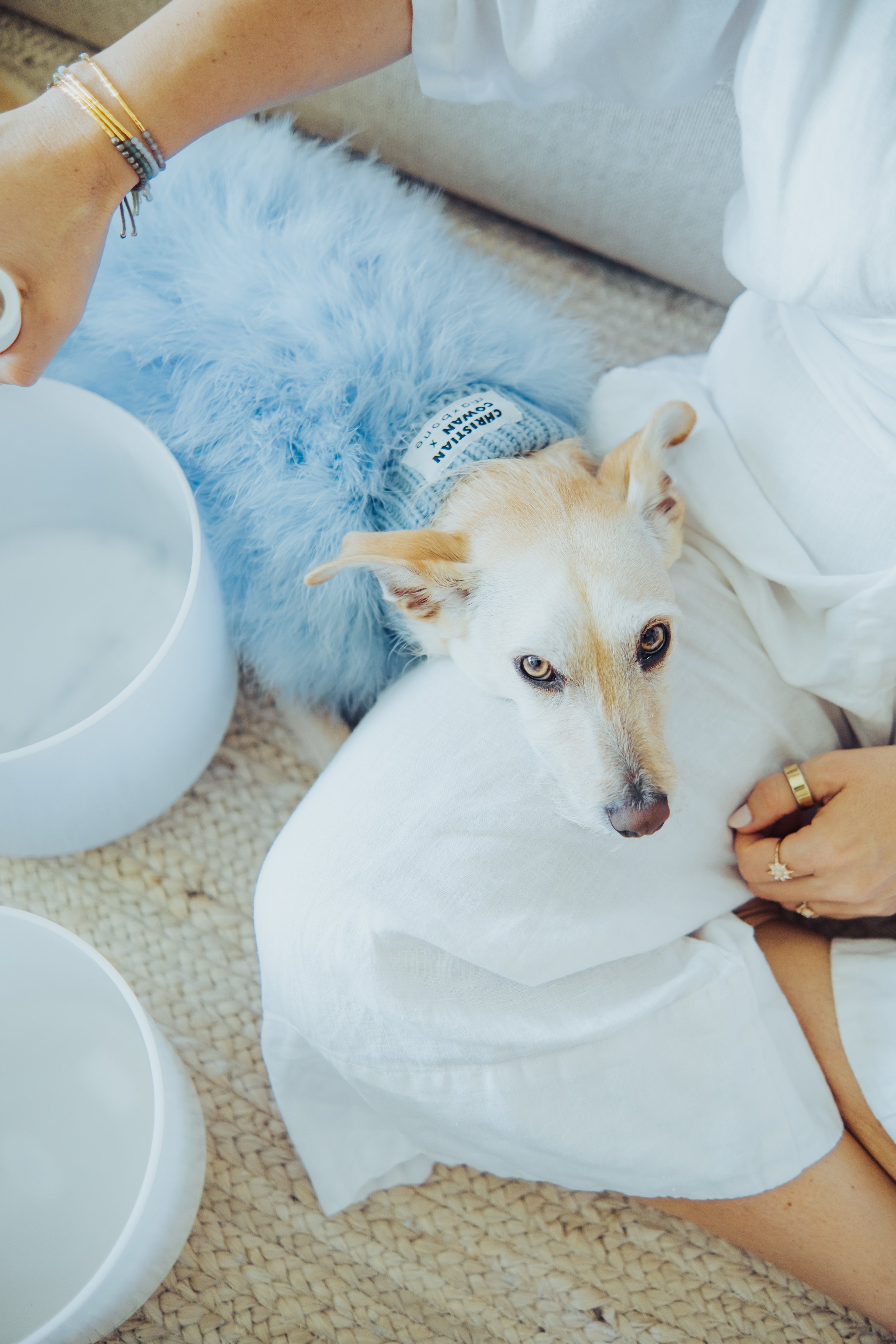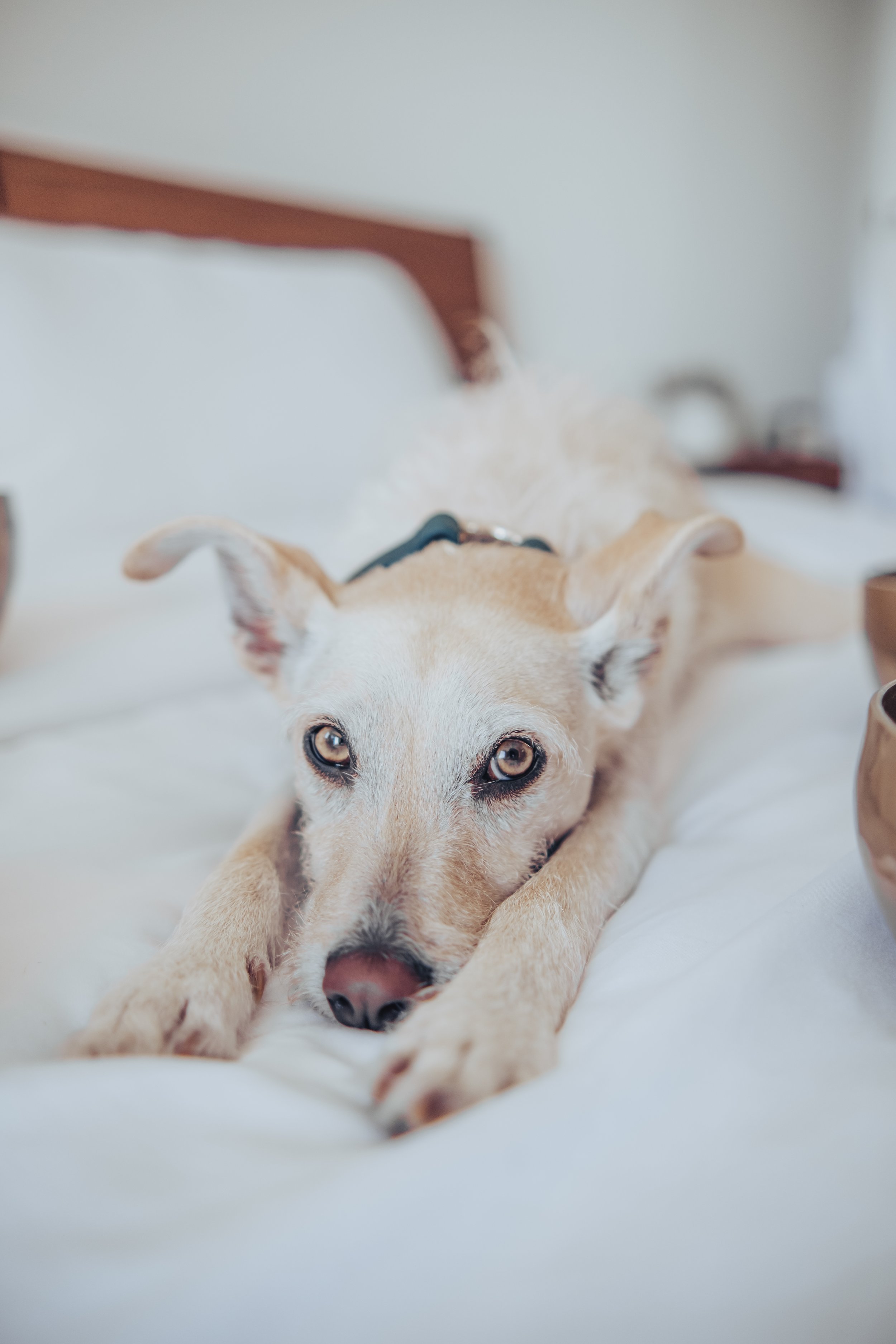How I Healed My Dog Zen
As many of you may know from Altha’s origin story, during the pandemic I adopted my adorable dog, Zen.
As he had a troubled history riddled with abuse and neglect, when I brought him home, he was a hot mess – scratching, mouthing, biting, and completely unable to rest. I had previous experience training dogs, and I did several behavioral courses and acting courses with my previous pups, but I had never experienced a dog that at such a young age was so traumatized. He was a very smart dog but was completely controlled by his emotions and overwhelmed with fear.
For a couple of months, I even had to keep him leashed while at home or else he would jump on the kitchen counters and tables and destroy everything I owned. I could not expose him to people or else he would start to mouth at them, jump on them, and attempt to (playfully) bite them on the nose. I could not leave him alone at home or he would panic and bark his lungs out until I returned. He would bark aggressively at anyone who would attempt to start a conversation with me – I remember when I would try to go to outdoor cafes, and he would get so worked up that he would start biting my legs or hands, so the majority of the time I had to just ask for a box and leave. He would pee if I would try to get my hands close to his face, he would attempt to eat poop from other dogs while on walks, he chewed on his leash as we were on walks and even escaped few times, I would fall on the floor from him pulling the leash so much, and he would get so bothered by the gardener blowing leaves or by the trash truck passing by that he would start biting my leg.
I went to many different trainers and behavioralists both in person and virtually and while everyone was able to share at least one good tip, most would say that he was a lost cause and that I had to either give doggy Xanax daily or consider putting him down. I was shocked by this as even though his progress was slow, he was learning many tricks fairly quickly. Since neither of these options were viable to me, I set on a journey to heal him myself. I hope by sharing this I can help others with their dogs that may be on the “naughty” side, here are the 3 phases I discovered that were most effective for helping him heal:
PHASE 1: STARTING OUT
The key to this phase is presence, patience, and compassion!
I made it a point to go at his pace, and not my own. Even if I wanted to cuddle him, I had to remind myself that I had to wait a few weeks until he was ready for it.
Strict boundaries are essential. While in the house I did not give him access to me whenever he wanted, and even if he wanted to go in different rooms, I would not allow it. When outside, I made it clear to other people and dog owners that he could not be pet and that he was not comfortable with other dogs.
I maintained a strict routine and schedule, so he always knew what to expect.
Each day I led 3-4 10-to-15-minute training sessions with a lot of positive enforcement, celebrating each tiny sign of progress.
I filled his areas in the house with many enrichment toys including puppy puzzles, snuffle mats, and automated toys.
I tried to heal his gut issues that were manifesting because of his anxiety by feeding him high-quality and nutrient-dense food from The Farmer’s Dog, apoptogenic treats from Botanical Bones, and probiotics from Calming Care by Purina.
Exercise is key. I ensured that I took him on plenty of long walks and gave him plenty of time at beach while I gave him my full attention by not going on my phone or engaging with other distractions.
I took him to day care often so he could socialize with other dogs and release some energy (I tried taking him to dog parks but that did not work for him as he would become aggressive to anyone who would try to get close to me). This also provided me with much-needed breaks as at times he became quite overwhelming to take care of.
I desensitized him with all the situations that were causing him anxiety (me getting close to the door, me putting on my shoes etc.) using a trick called counter conditioning. Here are some examples:
I started by putting him in his crate and in a position where he could see the front door (he remained in his crate during the exercises). I repeated each exercise 20 times a day and each time I gave him high value treat (freshly boiled chicken) no matter how he reacted.
Day 1: I walked close to the front door.
Day 2: I touched the front door and then walked back to give him the treat.
Day 3 & 4: I opened the door 4 inches.
Day 5 & 6: I opened the door fully.
Day 7 & 8: I opened the door, took one step out, then walked back in.
Day 9: I opened the door, took one step out, then partially closed the door.
Day 10: I opened the door, took one step out, then fully closed it.
PHASE 2: MAKING PROGRESS
Phase 2 began 8-10 months after I rescued Zen, but I definitely wish I knew these tips when I first got him as I think they would have made a definite impact.
I practiced sound healing (focusing on singing bowls) with him for 10 minutes daily in the morning and 10 minutes in the evening.
I constantly played high-vibrational music at home (like Ludovico Einaudi) throughout the entire day.
I attended several animal communication sessions and courses with Dana Dvorak, which significantly helped me understand his triggers and point of view.
I got him a crate that felt more like a home than a jail. The one I chose was a beautiful wooden option from Fable Pets that he now loves. As he willingly spends a lot of time in there while I am working, I wanted to get rid of the “jail” looking one that was making him uncomfortable as it reminded him of when he was at the animal shelter.
I started introducing him to healing crystals – he now loves them and has many favorites that he moves around the house, brings them to his crate, and even places them in his water bowl.
I was also thrilled when I discovered Merci Collective, as he can now wear obsidian on his collar 24/7!
PHASE 3: SIGNIFICANT IMPROVEMENT
A big part of this phase was working on my own fears of taking him out. Our feelings translate easily to our dogs so if we are worried, our dog gets worried. I realized how important it was that I always exude confidence and leadership, especially when we went outside.
I trained him to learn how to “speak” with recordable talking buttons so he could communicate better with me. When he pressed specific buttons, they said out loud words like “FOOD”, “WALK”, “PLAY”, “PUZZLE” and “RELAX” (for sound healing) – this was also super fun!
I introduced him to tapping (thanks to Dana Dvorak).
I have been running the Healy Animal Program from the Healy device on him for 2 hours each day with the programs that resonate the most with him, as well as checking his chakras and aligning them daily with the device.
I have been including him in my meditations – he always comes and sits next to me when I am meditating and once I am done with my own protection bubble meditation, I do one for him as well.
Soon I want to implement acupuncture and other holistic remedies for longevity – stay tuned!
After embarking full speed ahead on this healing journey with Zen, I am happy to say that he has undergone a drastic transformation.
While he is still a work in progress (as we all are), he is becoming calm and confident even in new environments, he is gentler with people when they come inside the house, he is not barking at other dogs when on walks, his tummy issues have been resolved, he is a total cuddle bug, and I was even able to expose him to children (in a controlled environment) and he did great! I am overjoyed that I can finally walk him with confidence, take him to restaurants, bring him to the dog beach, and he is calm and comfortable whenever I leave the house (I spy on him with Furbo)!
Zen has been and still is my biggest teacher, and I could not thank him enough for showing me my path and purpose of sound healing.
Here at Altha we make it a priority to be of service to less fortunate dogs – we volunteer at local rescues and shelters, and we love to support owners that have dogs with troublesome behavioral issues.
Interested in exploring sound healing for your pet? Connect with Us!
---
New to Altha? We are an LA-based modern sound healing group for humans and animals committed to creating bespoke experiences in Los Angeles, Beverly Hills, Marina Del Rey, Orange County and beyond!
-
A. Animal sound healing uses calming vibrations from instruments like singing bowls or gongs to help pets relax, reduce anxiety, and promote overall well-being. The soothing sounds can help regulate their nervous systems and create a sense of safety.
-
A. Sound healing can help reduce stress, alleviate behavioral issues, and support recovery from trauma or physical discomfort. It’s particularly effective for anxious pets or those who struggle with changes in their environment.
-
A. Yes, sound healing can benefit a variety of animals, including dogs, cats, and even horses. The key is to use gentle, soothing sounds tailored to their comfort level to create a calming and supportive environment.








